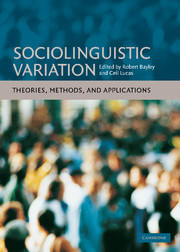Book contents
- Frontmatter
- Contents
- 1 List of figures
- 2 List of tables
- Acknowledgments
- Notes on editors and contributors
- Introduction
- Part 1 THEORIES
- 1 Variation and phonological theory
- 2 Syntactic variation
- 3 The psycholinguistic unity of inherent variability: old Occam whips out his razor
- 4 The study of variation in historical perspective
- 5 Style in dialogue: Bakhtin and sociolinguistic theory
- 6 Variation and historical linguistics
- 7 Second language acquisition: a variationist perspective
- 8 Variation and modality
- Part 2 METHODS
- Part 3 APPLICATIONS
- Afterword: Walt Wolfram and the study of sociolinguistic variation
- References
- Index
7 - Second language acquisition: a variationist perspective
Published online by Cambridge University Press: 16 February 2010
- Frontmatter
- Contents
- 1 List of figures
- 2 List of tables
- Acknowledgments
- Notes on editors and contributors
- Introduction
- Part 1 THEORIES
- 1 Variation and phonological theory
- 2 Syntactic variation
- 3 The psycholinguistic unity of inherent variability: old Occam whips out his razor
- 4 The study of variation in historical perspective
- 5 Style in dialogue: Bakhtin and sociolinguistic theory
- 6 Variation and historical linguistics
- 7 Second language acquisition: a variationist perspective
- 8 Variation and modality
- Part 2 METHODS
- Part 3 APPLICATIONS
- Afterword: Walt Wolfram and the study of sociolinguistic variation
- References
- Index
Summary
Introduction
The late 1960s and early 1970s witnessed the development of two subfields of linguistics: the quantitative study of linguistic variation pioneered by Labov (1966, 1969), Shuy (Shuy, Wolfram, and Riley 1968a), Wolfram (1969), and Fasold (1972), the focus of this volume, and the systematic investigation of second language acquisition (SLA), exemplified by studies such as Cazden, Cancino, Rosansky, and Schumann (1975) and Hakuta (1976). These two areas of research were motivated by a common concern to understand the underlying systems of language varieties, often socially stigmatized varieties in the case of quantitative sociolinguistics, and learner language in the case of SLA. Moreover, since its emergence as a distinct paradigm, variationism has been concerned with confronting the linguistic stereotypes of non-standard varieties by serious scientific study. Sankoff (1988a), for example, dates the development of variationism as a paradigm distinct from dialectology, ethnolinguistics, and traditional pidgin and creole studies from 1969, with the appearance of Labov's first major publication on the African American Vernacular English (AAVE) copula, rather than from 1963, the publication date of his study of Martha's Vineyard, or 1966, the publication date of his earlier work on New York City. The variationist paradigm was very quickly extended to speakers of other socially stigmatized language varieties, including American Sign Language (Woodward 1973), working-class British English (Trudgill 1974), Puerto Rican Spanish (Poplack 1980a), and Guyanese Creole (Rickford 1987), to name just a few.
Just as in variationist sociolinguistics, several early studies of second language acquisition focused on socially marginalized speakers, often working-class immigrants from the developing to the developed world.
- Type
- Chapter
- Information
- Sociolinguistic VariationTheories, Methods, and Applications, pp. 133 - 144Publisher: Cambridge University PressPrint publication year: 2007
- 7
- Cited by



